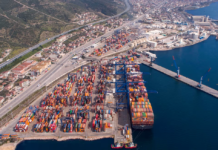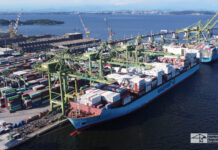
Clean Cargo, a group of companies which describes itself as a “business-to-business leadership initiative” supporting emissions reductions from within the supply chain, has published its latest report which details a reduction in carbon emissions from container shipping in 2019.
The 2019 report reveals a 5.6% reduction in carbon for dry containers in comparison to 2018 emissions and 2.5% for reefers from the 17 major carriers that are members of the group, and they comprise 85% of global carrier capacity, according to a statement.
In its report, Clean Cargo also breaks down emissions to trade lanes comparing the Pacific trades with Asia to North Europe. It shows that the United States (US) operations have seen double the carbon reductions of the European capacity. In particular, a 6% decline year-on-year is presented on the Pacific, while European trades see a 3% decrease.
Other trades, Asia to-from Middle East and India / Asia to-from Mediterranean / Black Sea both reported 12% reductions in carbon emissions.
Clean Cargo did not try to explain in its report why the trade with the largest ships had higher carbon levels, or how the Asia to Middle East and Mediterranean region had cut its emissions by four times those of the Asia to North Europe trade, given that many of the ships on these trades are the same vessels calling at interim ports en route from Asia to northern Europe and the Mediterranean.
Container News contacted Clean Cargo for an explanation, but the group was unavailable for comment.
However, a prominent naval architect told Container News that the figures do show a trend and that the trend is largely in the correct direction for the major trades. That is not necessarily the case for some of the less prominent routes such as those to and from South America and Africa.
It is also difficult to know in detail from these figures what the waiting times in port are, what speeds vessels were travelling at, the weather and other conditions that they encountered on their journeys. In addition, the figures will be affected by utilisation levels which are also largely unknown.
Clean Cargo’s statement does, however, say that, “A mapping of Clean Cargo’s membership divided by vessel size and type shows a clear increase in the fleet size, which results in an increase in the total amount of fuel consumed by the group.”
The report also explained that every year, Clean Cargo collects data from container cargo carriers and produces carrier-specific trade lane emissions. These details are only available to Clean Cargo members on the organisation’s website:
- Trade lane CO2 (Dry and Reefer) emissions by carrier and average of Clean Cargo (in gCO2/TEUkm)
- Trade lane SOx emissions by carrier and average of Clean Cargo (in gSOx/TEUkm)
- Year-on-year comparisons for CO2 (Dry and Reefer) and SOx by trade lane and carrier.
The initiative is supported by Business for Social Responsibility (BSR), which is the same group that will handle the new Transform to Net Zero which a number of companies, including shippers and liner operators, have joined to collaborate on the shift from fossil fuels.
Clean Cargo counts most of the largest container shipping lines amongst its members as well as shippers such as Mark & Spencer, Michelin and Amazon and freight forwarders such as Schenker, Kuehne + Nagel, DSV and DHL.
Nick Savvides
Managing Editor





